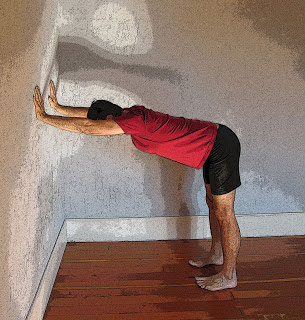by Nina
 |
| Sitting by Nina Zolotow |
Yesterday’s New York Times article “Get Up. Get Out. Don’t Sit.” reported that two different scientific studies have added to a growing consensus that “the more time someone spends sitting, especially in front of the television, the shorter and less robust his or her life may be.”
The studies, including one published in the October issue of The British Journal of Sports Medicine the other published on Monday in the journal Diabetologia, looked at TV watching habits as a way of learning more about the effects of sedentary behavior on health. The conclusions? Sitting actually reduces your life expectancy. An adult who spends an average of six hours a day watching TV over the course of a lifetime can expect to live 4.8 years fewer than a person who does not watch TV.
“Every single hour of television watched after the age of 25 reduces the viewer’s life expectancy by 21.8 minutes.”
Unfortunately, for us yoga practitioners, the results are true even for people who exercise regularly. The article quotes one of the authors of the study in the British Journal of Sports Medicine, Dr. Verrman, saying, “a person who does a lot of exercise but watches six hours of TV every night might have a similar mortality risk as someone who does not exercise and watches no TV.”
Furthermore, it’s not just TV watching itself that causes the problems. In modern society, many of us—including me!— have jobs that require sitting in front of the computer all day. Dr. Emma Wilmot, a research fellow at the University of Leicester in England, says that while we might try to convince ourselves that 30 minutes of exercise a day will protect us, we “are still at risk if we sit all day.”
The author of the article goes on to speculate way this may be true, quoting David W. Dunstan, a professor at the Baker IDI Heart and Diabetes Institute in Australia, senior author of the Australian study, and a pioneer in the study of sedentary behavior, “The most striking feature of prolonged sitting is the absence of skeletal muscle contractions, particularly in the very large muscles of the lower limbs.” The thinking is that when your leg muscles don’t contract, they require less fuel, and the surplus, in the form of blood sugar, accumulates in the bloodstream, contributing to diabetes risk and other health problems.
The article recommends reducing the hours you spend sitting, starting eliminating one hour of sitting a day. And you just know that I’m going to recommend some yoga! Obviously, if you have not already done so, incorporating standing poses (those really cause your leg muscles to contract!) into your daily practice is vital. But what about outside the yoga room? How about taking a short break and doing some office yoga? Our office yoga series includes some seated poses, but we also have a number of poses you can do in your office attire that require getting up and out of your chair!

Try one or more of our Standing Shoulder Stretches. Or how about our Standing Leg Stretches? Even Half Dog pose at the Wall, which you can do almost anywhere (try putting your hands flat on the desk, if you don’t have a free wall space) and in any attire, requires getting out of your chair and moving those legs!
Follow Yoga for Healthy Aging on Facebook ° To order Yoga for Healthy Aging: A Guide to Lifelong Well-Being, go to Amazon, Shambhala, Indie Bound or your local bookstore.


I couldn't agree more. Chairs Kill!